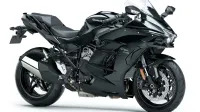Kawasaki files patent for electric supercharger on a hybrid motorcycle

Kawasaki’s been working on an electric motorcycle for at least a decade. The Japanese bike maker showed a two-wheeled electric concept at the EICMA show in Milan in 2019, but its specs seemed more suited to a scooter or moped. The e-motor in that show bike spun a continuous 13.5 horsepower and peaked at 27 hp. A flurry of patent applications over the two years have put words to Kawasaki intentions for a hybrid motorcycle as well, and it seems that hybrid might get forced induction. Motorcycle.com just discovered a patent for an electric supercharger that would run off the electric portion of the powertrain.
There have been a few powertrains drawn up in patents, so it’s hard to tell what Kawasaki has in mind for a final result or results. The electric concept from 2019, known as Endeavor, was set into a Ninja 300/400-based tube frame, its electric motor powered by a large, removable battery. The motor was hooked up to a conventional motorcycle transmission with four speeds instead of six. Performance has been said to rival a 400-cc bike even though the Ninja 300 makes a fraction under 40 hp and the Ninja 400 makes 44 hp.
Then came patents for plug-in hybrid bikes in late 2020 with four power modes, a small electric motor adding more power to the ICE or powering the bike on its own. These patents also included descriptions of drive modes like “a fuel economy mode and a sporty travel mode,” and contained drawings of a “Boost” button that would “change the torque output characteristic so as to increase the output torque of the hybrid power source.” The placement of the boost button depended on the kind of bike was using it. In May of this year, the company applied to patent the term “E-boost” in Japan.
The company already has four supercharged models, the H2, H2R, H2 SX, and Z H2, each of which runs a chain-driven screw off the engine’s crankshaft. The patent drawings show the e-motor still able to run the bike on its own, or aid the combustion engine as a proper hybrid in HEV mode, and power the supercharger when the ICE is the prime mover in Normal mode. Engineers appear to have programmed two-stage supercharger activation; the e-motor spins at around 5,500 rpm to create “weak supercharging” for the combustion engine in mild throttle applications while still being connected to the input shaft via a clutch. Under hard throttle, the clutch disengages the e-motor from the input shaft and the e-motor runs beyond 6,000 rpm, up to 15,000 rpm, to send all its power to the supercharger. It’s now thought that E-boost is for this full-power supercharger state, instead of applying to output from the electronic portion of the powertrain.
All we really know now is what Kawasaki motorcycle president Hiroshi Ito told us, which is that “in the near future” we’ll see “innovative new street motorcycles, our new electric, hybrid, and hydrogen power source projects and off-road motorcycles.”




